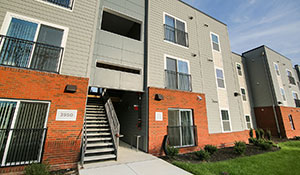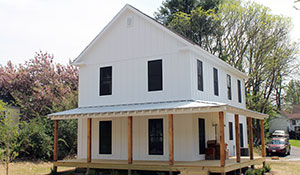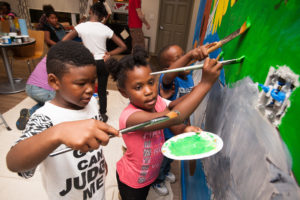February 1, 2016
In 2014, CHP and the Hopewell Redevelopment and Housing Authority (HRHA) partnered to redevelop and expand the 30-unit public housing community called Langston Park using funding from the Virginia Housing Development Authority’s highly competitive nine percent Low-Income Housing Tax Credits (a first for the city of Hopewell) and the U.S. Department of Housing and Urban Development’s new Rental Assistance Demonstration (RAD) program (a first for the Commonwealth of Virginia). As the owner, developer, architect, and contractor of the mixed-income rental community, CHP demolished the existing out-of-date units and constructed 56 new, attractive and energy efficient apartments. The updated five-acre community, renamed The Summit at Hopewell, is home to families earning at or below 50 percent of the Area Median Income, with 30 of the apartments allotted for residents receiving HUD Project-Based Rental Assistance through the RAD program.
In keeping with CHP’s commitment to creating environmentally, economically, and socially sustainable communities, the renovation incorporated an all-new community center for resident use and services. CHP considers resident services to be a critically important part of neighborhood development, and that on-site services and resident engagement activities help to make communities safer, higher quality places to live. In Hopewell, the transition of the rental community from public to private ownership and management created a unique challenge for CHP: from the earliest phases of the project’s development, CHP and HRHA recognized the importance of easing the physical and emotional transition for The Summit’s existing and new residents.
As both property manager and resident services provider, CHP began work even before construction was completed to engage residents so they would feel as if they had a voice in their new community. One important engagement method that CHP explored was community involvement in the creation of public art. Throughout history, public or community art has frequently been employed to invigorate residential and commercial spaces as well as to provide insights into the unique culture and history of a community or geographic area. With this knowledge, CHP decided to implement the collaborative creation of a mural in The Summit’s new community center.
CHP Internal Communications and Multimedia Specialist Jackie Harder recently completed a graduate program that focused her research on community mural making. A skilled artist herself, Harder was motivated to lead a community mural making process at the Summit so that the residents might feel a greater sense of ownership in their community. “I wanted us to develop a product that could spark conversation and reflect residents’ experiences. My hope was that by helping paint a mural together, the residents would feel as if the space was truly theirs,” said Harder.
The process began with a design workshop facilitated by Harder in which youth residents and a local partner organization brainstormed mural ideas around the theme of “hope,” which was inspired by the city’s name of Hopewell. Unfortunately, the session began with less-than-positive references to the impoverished community, resulting in initial feedback such as, “There is no hope for Hopewell.” Determined to channel this negative energy into something productive, Harder encouraged the children to actively visualize positive thoughts about their community.
The workshop participants then drew what came to mind, ranging from the bridging of two hands and symbols of happiness and love to flowers, trees, and children playing. Afterward, Harder collected the images and integrated them into one cohesive design. “As the artist, I incorporated the children’s ideas and created a composition that drew on some historical elements of the town and also served as an artistic vision of hope, peace, and interconnection for the city of Hopewell. The children and I essentially worked together to create a shared vision for the mural,” explained Harder.
Harder then returned to the community to draw an outline of the mural on a wall in the community center, which was then painted in by young residents. According to Harder, “The process was organized as a large-scale paint-by-number exercise so that little to no skill or art experience was necessary.” After the afternoon-long collaborative painting session was completed, Harder and an assistant finished and finalized the mural details to ensure a high-quality final product. In total, the mural took three days to paint.
The Summit mural project was a constructive community-building and ownership activity for the children who participated. It also provided its youth participants with an opportunity to work collaboratively to accomplish a goal and to reflect on the role of the community and their place in it. According to Harder, the process was a self-confidence-building exercise for the youth (for both themselves and their community) and it provided a constructive outlet for children to channel their natural energy and not-uncommon urges to mark or brand blank spaces. In addition, The Summit community gained a mural that serves as a positive affirmation and symbol of the community’s hopes and aspirations.
Harder reported that the mural painters were “enthusiastic and excited,” typically wanting to paint more than time allowed. In fact, as word spread the day of the mural painting, over 38 children and parents showed up to paint—far exceeding resident services staff expectations of about 15 to 20 participants. The youngest mural painter was three-years-old while the oldest was 60.
Zahnae Morse, age nine, worked on the mural and declared her favorite part of the artwork to be a pair of hands coming together to form a bridge and some of the flowers. When asked if she would ever like to participate in a mural project again, Morse responded in the affirmative, saying she would like to, “…show people how much I like to paint and inspire them.”
Eight-year-old Gerkhasia Waller noted that she enjoyed the mural project because, “It looks good and I’m proud of myself for helping make it.”



